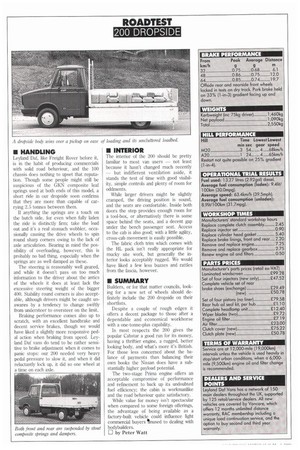• HANDLING
Page 42

If you've noticed an error in this article please click here to report it so we can fix it.
Leyland Dal, like Freight Rover before it, is in the habit of producing commercials with solid road behaviour, and the 100 chassis does nothing to upset that reputation. Though some people might still be suspicious of the GICN composite leaf springs used at both ends of this model, a short ride in our dropside soon confirms that they are more than capable of carrying 2.5 tonnes between them.
If anything the springs are a touch on the butch side, for even when fully laden the ride is distinctly firm; take the load out and it's a real stomach wobbler, occasionally causing the drive wheels to spin round sharp corners owing to the lack of axle articulation. Bearing in mind the possibility of overloading, however, this is probably no bad thing, especially when the springs are as well damped as these.
The steering is reasonably well geared, and while it doesn't pass on too much information to the driver about the antics of the wheels it does at least lack the excessive steering weight of the bigger 400. Stability round corners is also acceptable, although drivers might be caught unawares by a tendency to change swiftly from understeer to oversteer on the limit.
Braking performance comes also up to scratch, with an excellent handbrake and decent service brakes, though we would have liked a slightly more responsive pedal action when braking from speed. Leyland Daf vans do tend to be rather sensitive to brake adjustment when it comes to panic stops: our 200 needed very heavy pedal pressure to slow it, and when it did reluctantly lock up, it did so one wheel at a time on each axle.
• INTERIOR
The interior at the 200 should be pretty familiar to most van users not least because it hasn't changed much recently but indifferent ventilation aside, it stands the test of time with good visibility, simple controls and plenty of room for oddments.
While larger drivers might be slightly cramped, the driving position is sound, and the seats are comfortable. Inside both doors the step provides enough room for a tool-box, or alternatively there is some space behind the seats, and a decent gap under the bench passenger seat. Access to the cab is also good; with a little agility, cross-cab movement is easily possible.
The fabric cloth trim which comes with the HL pack isn't really appropriate for Mucky site work, but generally the interior looks acceptably rugged. We would have liked a few less buzzes and rattles from the fascia, however.
• SUMMARY
Builders, or for that matter councils, looking for a new set of wheels should deimitely include the 200 dropside on their shortlists.
Despite a couple of rough edges it offers a decent package to those after a dependable and economical workhorse with a one-tonne-plus capability.
In most respects the 200 gives the popular Cabstar a good run for its money, having a thriftier engine, a rugged, better looking body, and what's more it's British. For those less concerned about the balance of payments than balancing their own books the Nissan does have a substantially higher payload potential.
The two-stage Prima engine offers an acceptable compromise of performance and refinement to back up its undoubted fuel efficiency; the cabin is workmanlike and the road behaviour quite satisfactory.
While value for money isn't spectacular when compared to some foreign offerings, the advantage of being available as a factory-built vehicle could influence light commercial buyers t nused to dealing with bodybuilders.
by Peter Watt




















































































































































